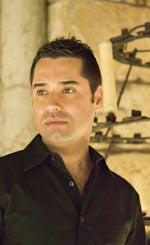 He lowers himself into another large pot. His job is simple: clean the insides. As José Lemos ’01 scrubs away sticky pasta residue, he softly sings to himself, enjoying the unusual acoustics of his metallic environment. That enjoyment, however, is fleeting. While Lemos appreciates his job at the pasta factory, he dreams, not surprisingly, of performing in venues larger than a man-sized pasta bin.
He lowers himself into another large pot. His job is simple: clean the insides. As José Lemos ’01 scrubs away sticky pasta residue, he softly sings to himself, enjoying the unusual acoustics of his metallic environment. That enjoyment, however, is fleeting. While Lemos appreciates his job at the pasta factory, he dreams, not surprisingly, of performing in venues larger than a man-sized pasta bin.
What got Lemos into that pasta bin to begin with also got him out: talent and a little luck.
As a child growing up in Bagé, Brazil, Lemos did not start out as the best singer in the children’s choir, but he was the loudest. His music teachers often rewarded his enthusiasm by giving him the solos.
As his voice matured, so did his music appreciation. While other kids clamored for pop music acts such as Boy George and Duran Duran, Lemos browsed a different section of the local music shop. At age 12, he purchased his first cassette– international opera sensation Maria Callas’s selected arias. “I wasn’t surrounded by opera at home,” Lemos admits. “My mother listened to Elvis. But when I heard opera in town, it just spoke to me. It was so beautiful.”
And then began a series of happy accidents. After buying that cassette, Lemos landed a spot in an adult choir. Then, after the choir’s performance of Lehár’s opera The Merry Widow, a vocal coach in the audience took note of his strong voice. For an entire year, Lemos worked with that music teacher on his vocal technique, singing only two songs from an Italian book of arias.
Prospects for a full-time musical career in Bagé were bleak, so after graduating from high school, Lemos taught at a local elementary school. But, he still practiced and performed in various evening recitals. Then came The Break, Part I.
In the audience one night was a most unlikely patron of the arts. Impressed by Lemos’s countertenor range, he offered Lemos a job in his pasta factory in Montevideo, a city with greater musical opportunities. The job cleaning pasta bins eventually turned into a waitstaff position at the factory owner’s new restaurant, where Lemos served and sang to the customers.
During this time, Lemos continued to perfect his technique with more evening lessons and performances. Then came The Break, Part II. Music chair Steve Rosenberg was in town for a concert, and at the after-party, he heard Lemos singing a few Baroque arias. “Steve asked me if I would be willing to learn Renaissance music, his particular area of interest. And if so, there might be a scholarship,” he remembers. “Without hesitation, without even knowing the particulars of Renaissance music, I told him, ‘Of course, I would.’”
One scholarship, one summer-long crash course in English, a few tearful goodbyes and nearly 5,000 miles later, Lemos was in Charleston – a place he had never heard of before he met Rosenberg. “The College was great. Every music major gets an opportunity to perform here,” he explains. “You can study and practice all of your life, but if you don’t perform, you don’t really know the music. More than half of what you do you learn while doing it onstage.”
After graduation, Lemos completed a master’s in vocal performance at the New England Conservatory, and then, The Breaks came in quick succession. He was a soloist with the Boston Symphony and also won first prize and an audience prize at the 2003 Baroque Singing Competition in Chimay, Belgium. More doors began to open. He performed at the Tanglewood Festival in 2004 and was featured in The New York Times for his role as Oberon in A Midsummer Night’s Dream.
“This is what I am meant to do,” Lemos says with a smile. “Performing … connecting with an audience … creating that energy … telling a story through music.”
Today, Lemos has “told stories” on three continents and counting; he serves as the main guest artist with the Baltimore Consort (a touring early-music ensemble); and he garners praise from audiences and critics alike for his voice and stage presence. Most recently, he sang at the National Gallery in Washington, D.C., and then played his favorite opera role, Ottone in L’incoronazione di Poppea, to packed houses at the Seattle Center’s Intiman Playhouse.
Not a bad step up from a pasta bin.
– Mark Berry
Photography by Guy Roberts




